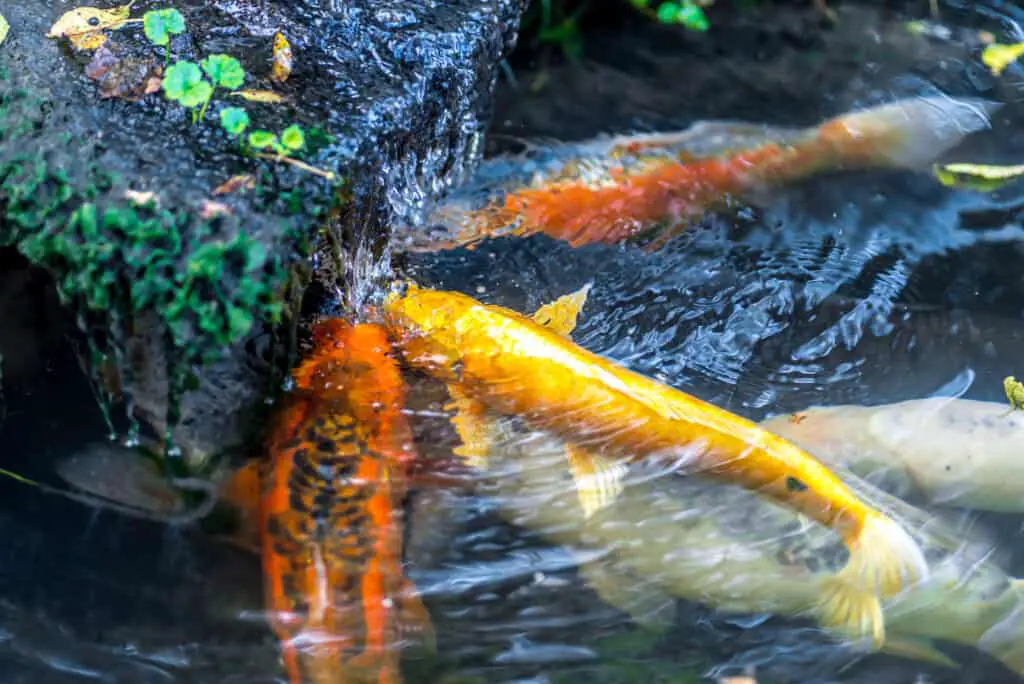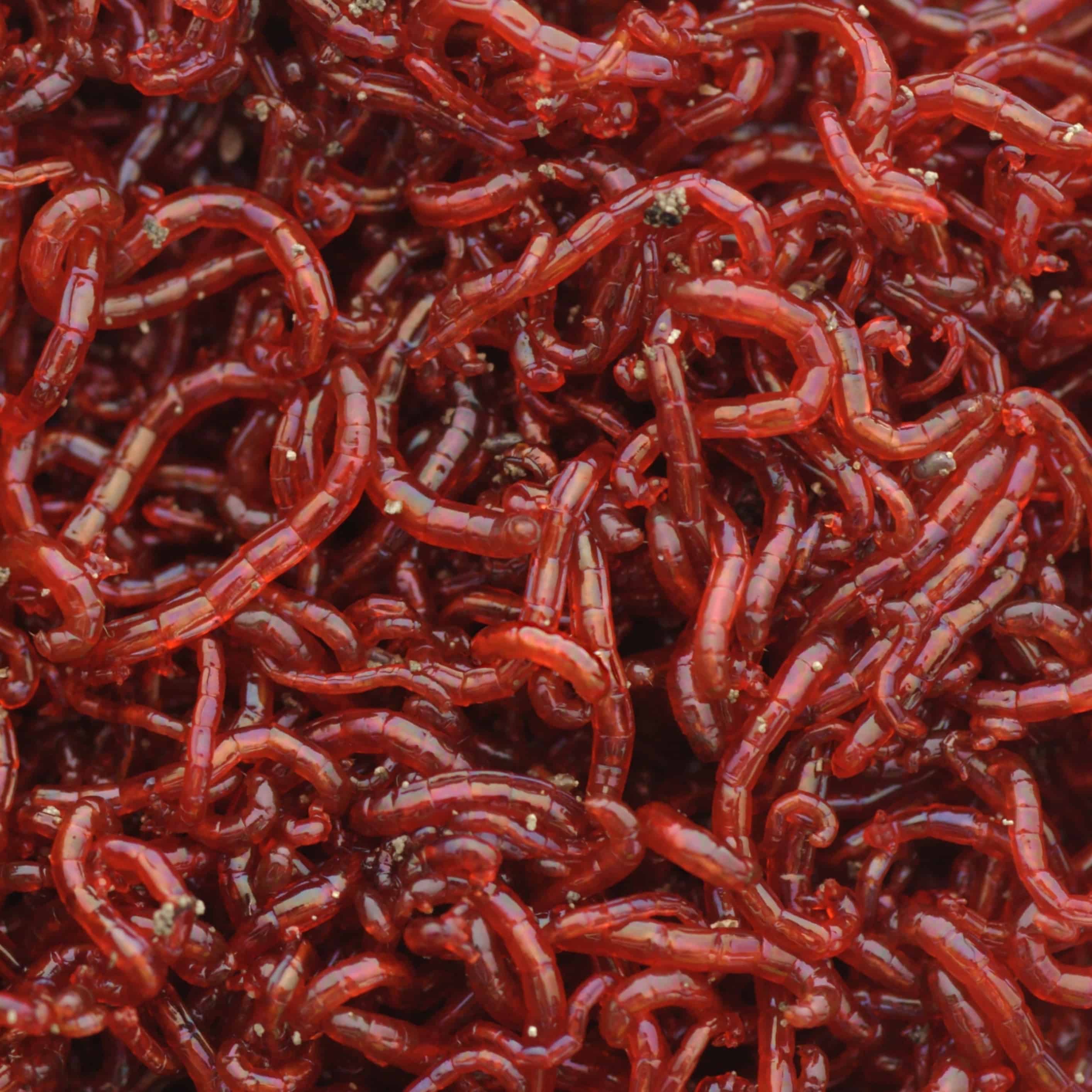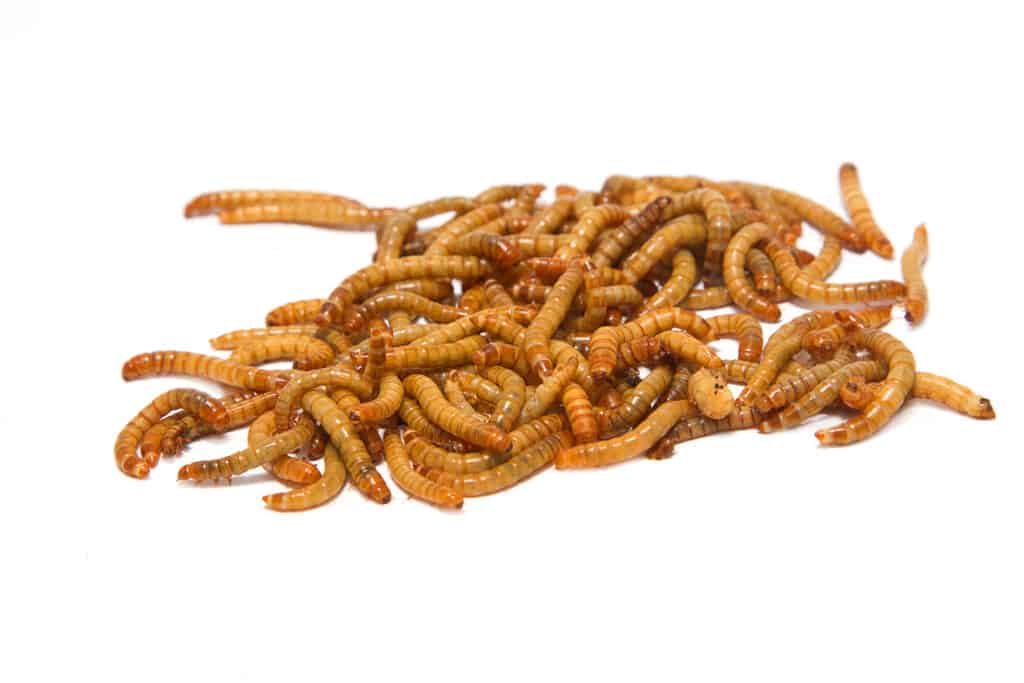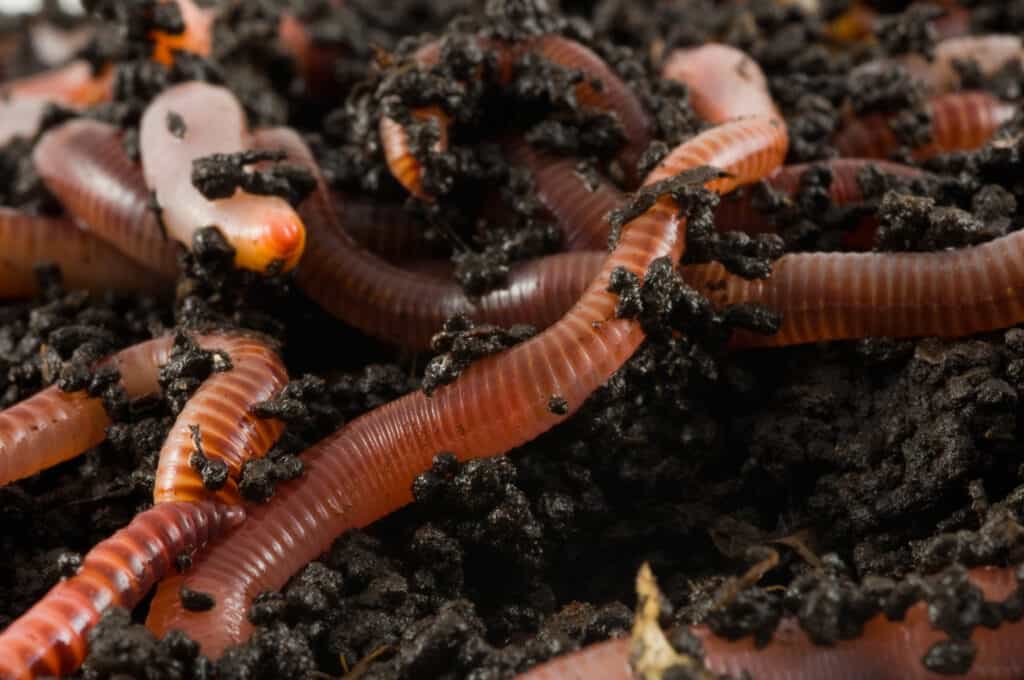
You may be wondering what food you can give your koi to supplement their pellets, and you’ve read that bloodworms and other worms are suitable for feeding koi fish. Or you may have an infestation of bloodworms in your pond filter, and you’re wondering if you can feed them to your koi. We give you a complete guide to koi fish-eating worms so that you can optimize your fish’s diet.
Bloodworms are an excellent supplemental food for koi, high in protein and iron. Other worms, such as earthworms and mealworms, are also suitable as supplementary food for koi fish. However, it would be best if you did not feed them worms more than twice a week to prevent nutritional deficiencies.
There’s quite a bit to know about feeding bloodworms and other worms to koi. Join us to investigate how to feed your beloved koi fish these tasty treats without compromising their health by providing them with an unbalanced diet or one that can cause nutritional deficiencies.
Pro Tip: If you’re tired of wasting money and making costly mistakes on the koi-keeping hobby or are thinking about buying koi fish but don’t know where to start, I strongly suggest you check out this ebook. I recently read this ebook, and it contains SO much useful information, such as:
- 3 proven steps to identify koi fish diseases
- WARNING: 3 things you should NEVER do when it comes to caring for koi
- When to seek professional help when it comes to looking after your koi
Are Bloodworms Good For Koi?

Bloodworms are excellent supplemental food for your koi fish. They will supply plenty of protein (as much as fifty-five percent protein) and other nutrients such as iron that your fish need for growth, reproduction, and healthy color.
You can feed your koi fish bloodworms a couple of times per week, in various forms: live, frozen, or freeze-dried (although the nutritional value is not the same).
In addition to the nutritional value of bloodworms and other worms, these live foods add interest and variety to your fish’s diet.
What Are The Bloodworms That Are Fed To Koi?
Considerable confusion exists around the name ‘bloodworm.’ At least three different types of organisms are known as bloodworms; only one of these you typically feed to koi fish.
The bloodworms fed to koi are the larvae of non-biting chironomid midges and do not grow more than a couple of inches long. They are harmless to you and your fish. The only precautions you will need to take are preparing them for your fish and how often you feed them to your koi.
There is also a genus of marine worms, several inches long, called bloodworms, for their color. The name of this genus is Glycera. These worms have bizarre quadruple copper jaws and a venom that is chemically related to wasp venom, causing a severe allergic reaction if they bite you.
Although fish are crazy for Glycera bloodworms, humans generally encounter them in the context of bait for fishing, not food for pond fish. So your chances of being bitten by one when preparing food for your koi are remote!
Another organism, sometimes known as bloodworms, are parasites in the genus Schistosoma, which enter humans’ bloodstream from water inhabited by certain freshwater snails (that host the worms) and migrate to the liver and intestines, causing a disease known as schistosomiasis or bilharzia. This parasite is widespread in tropical regions of the world but does not occur in the United States.
Precautions When Feeding Bloodworms To Koi
So, how should you prepare bloodworms for your koi fish, and how often should you feed them?
If you have fresh bloodworms from a source such as a drainage ditch or your pond filter, you can feed them to your koi as is. If you have frozen bloodworms, thaw a quantity enough for one feeding and drain off the excess juice, as the koi will not eat this, which can affect water quality.
You could also feed your fish freeze-dried bloodworms, but these are more expensive, and the freeze-drying process results in a loss of nutrients. Freeze-dried bloodworms are therefore not a very nutritious option, and we do not recommend them.
Because bloodworms lack certain amino acids and are short of some vitamins and minerals, you should only feed them to your fish as a snack and not as a staple. We recommend feeding them bloodworms no more than two times per week.
The Life Cycle Of Bloodworms In Ponds
Non-biting chironomid midges resemble tiny mosquitoes but do not feed on blood. These midges lay their eggs on the surface of ponds, streams, and ditches. The eggs sink and the larvae hatch a few days later.
The larvae consume organic material in the water, helping to keep it clean. They are red due to their high amount of hemoglobin, which allows them to survive in oxygen-poor water. After two to seven weeks, they pupate. After three days as a pupa, they swim to the water’s surface and transform into adult chironomid midges.
The larvae play a beneficial role in maintaining water quality in their habitats and consuming excess algae and other organic material. If you have them living in your pond, usually in a protected area such as the filter, take it as a good sign. These worms will help to maintain the water quality in your pond.
The larvae also serve an important ecological role, being an important food source for fish, frogs, and birds. They provide lots of protein, and their high hemoglobin concentrations mean they are rich in iron.
Should I Try To Breed Bloodworms To Feed My Koi?
If you are fortunate enough to have bloodworms breeding in your pond, we suggest leaving them to reproduce and harvest only sufficient to feed your fish, leaving the rest to mature into midges.
Keeping the adult midges in one place can be challenging and almost impossible to know whether they have successfully mated. For this reason, you will find trying to breed them deliberately an exercise in frustration that will take away from your enjoyment of your fish pond.
You will need a large enclosed area, such as a greenhouse, to contain the chironomid midges and get them to swarm to breed. As a result, raising bloodworms is unfeasible for most fishkeepers and definitely, more trouble than it’s worth.
You can raise chironomid larvae from eggs, feeding them on manure. However, this will not get you a complete life cycle.
We recommend that if you do not have bloodworms in your pond and wish to feed them to your fish, you purchase frozen bloodworms from managed canals in northern China and Siberia (the primary commercial source) and use them to feed your koi fish.
Other Worms That You Can Feed To Koi

In addition to bloodworms, you can also feed earthworms and mealworms to your koi fish. Earthworms are worms that live in the soil and feed on decaying matter. You can dig them up, or you could farm them. Mealworms are the larvae of small beetles and are easy to obtain or raise yourself on various cheap foodstuffs.
Earthworms are an excellent and easy-to-digest source of nutrients; you can provide them as supplemental food year-round. They are easy to raise in your garden, allowing you to maintain a steady supply.
Mealworms are packed with nutrients and make excellent supplemental food for your koi. However, you should be prepared for it to take a while for your fish to warm up to eating them, as their chitinous exoskeleton is relatively harder to digest than other, softer foods, and your koi fish may not initially like them.
How To Grow Mealworms For Feeding To Koi

As it can become inconvenient and expensive to constantly purchase live mealworms from your local pet shop, we recommend that you raise your own.
Their life cycle takes about two months, and all you will need are a starter supply of mealworms, food to raise the mealworms on, and a habitat for them to live in.
Mealworms only feed as larvae and stop eating when they become adult beetles. The larvae can be fed dog food, poultry mash, and grains such as wheat bran, corn, barley, and oats.
To raise mealworms, do the following:
- Get a small plastic storage bin and poke holes in its lid, or buy a vented container for raising mealworms from your pet shop.
- Place a couple inches of oats in the bottom of the container to serve as the substrate for mealworms. They will burrow in this and feed on it.
- Place half a raw potato in the container for your mealworms to feed on and provide them with a source of moisture.
- Buy around two dozen mealworms from your local pet shop to act as a starter colony.
- Place the mealworms in the container, and ensure that it stays relatively warm, as mealworms’ development stops if they get too cold (this is why pet shops sell mealworms refrigerated). In winter, you can place a cheap heating pad under the container.
- Replace the potato every couple of days to provide your mealworms with a source of food and water.
- After around three weeks, the larvae will pupate, and the adult beetles will emerge in another two weeks. These will mate and lay tiny eggs.
- The adult beetles will die, while the eggs will grow into a new crop of larvae. By this stage, your colony should be well established, and you will be able to start feeding mealworms to your koi fish.
- Feed the colony supplemental foods such as leafy greens, citrus pieces, and carrots to increase the nutritional value of the mealworms.
How To Prepare Mealworms For Feeding To Koi
Preparing mealworms to feed your koi is as simple as scooping them out of their habitat and sifting out their substrate, leaving only the mealworms. You can then feed these mealworms directly to your koi. Some people have expressed concern about mealworms possibly biting koi, and if this worries you, you could try chopping the mealworms’ heads off. However, we do not think this is necessary.
How To Grow Earthworms For Feeding To Koi

The main earthworm used for feeding fish in the United States is the red earthworm (Lumbricus rubellus). These worms mature in 179 days, produce from 80 to 100 cocoons per worm at maturity, and live approximately 700 days.
You can raise them by constructing a bed with enough organic material, drainage, and temperature control.
Construct the bed using wooden sides to create a permanent structure that will contain the worms and prevent them from moving beyond the worm bed.
Build it under an overhanging roof to regulate temperatures, help prevent flooding, and lay a foundation of gravel, sand, and a perforated septic tank drainage line. Then fill the bed with topsoil with a high percentage of organic material (approximately two parts topsoil to one part well-decayed organic matter).
.
Stock the bed with 100 to 500 red worms per square foot of bedding area. Lower stocking densities will result in larger worms. After around one month, the worms will be ready to reproduce, and after about six months, they will have reached their full size.
You will obtain around 4 to 5 pounds of worms per square foot of bedding area per year.
Feed your earthworms with kitchen waste, ground livestock feeds, or fresh manure mixed with water. Sprinkle dry feeds on the bed and water them in. Feed every 3 to 5 days, avoiding overfeeding.
How To Prepare Earthworms For Feeding To Koi
Preparing earthworms to feed koi is as simple as digging them up and rinsing them free of soil. You can then throw them to your koi for them to enjoy.
Conclusion
Not only can koi fish eat worms such as bloodworms, mealworms, and earthworms, but we highly recommend that you source these live foods for your koi, as they provide variety in their diet and supplement it with nutrients such as protein and iron. Make sure not to feed your fish these foods too often, to prevent nutritional deficiencies.
Bloodworms are challenging to raise, and unless you have live bloodworms in your pond, we recommend buying frozen ones for your fish. On the other hand, mealworms and earthworms are easy to raise, and you can easily keep up a steady supply of these foods for your koi fish. These foods will provide your fish with a boost of nutrients and help to keep them happy.
References
https://homeguides.sfgate.com/bloodworm-larvae-koi-ponds-51498.html
https://animals.mom.com/live-food-koi-eat-10672.html
https://www.thesprucepets.com/how-to-raise-mealworms-1237234
https://extension.psu.edu/earthworm-production
https://www.gardenguides.com/13425540-what-are-the-tiny-wiry-red-worms-in-the-pond.html

